Are you struggling to meet the demands of consistently producing fresh and engaging content? If so, it’s time to revamp your content strategy and discover the ultimate guide for repurposing content in 2023. In this fast-paced digital landscape, where attention spans are shorter than ever, it’s crucial to make the most out of every piece of content you create. Repurposing content allows you to breathe new life into your existing assets, reach a wider audience and maximize your return on investment. But this isn’t just about recycling old blog posts or resharing social media updates. An experienced provider of content writing services can assist businesses in getting unique content formats.
Our 2023 guide for content repurposing will unveil powerful strategies and techniques that will take your content game to the next level. From transforming blog posts into visually stunning infographics to turning video content into engaging podcasts, this guide will equip you with the knowledge to make your content go further and make a lasting impact on your audience.
What Is Repurposing Content?
Repurposing content refers to the process of taking existing content and adapting it for use in different formats or across various channels. It involves adding to or heavily revising your content, repackaging, modifying, or republishing existing content to add more value in different ways, or extend the lifespan of the content and thus reach a wider audience. Your previous blogs and any other content form can be revitalized, so they work harder for your SEO.
By repurposing content, you can maximize its reach and impact, cater to different audience preferences, and optimize your content marketing efforts.
By repurposing content, you can maximize its reach and impact, cater to different audience preferences, and optimize your content marketing efforts.
Some common examples of content repurposing are blog to social media snippets or quotes, podcast to blog, infographics to presentations, e-book to email series, webinar to video tutorial, expert interviews to articles, case studies to testimonials, and blog series to e-book.
Benefits of Repurposing Content
Repurposing content offers several benefits that can help maximize the value of your existing content and enhance your content marketing strategy. Here are some key benefits of repurposing content:
- Reach a wider audience: By repurposing content into different formats and across various channels, you can reach a larger audience. Different people prefer consuming content in different ways, so repurposing allows you to cater to diverse preferences. You can target those who prefer reading articles, listening to podcasts, watching videos, or engaging with visual content.
- Extend content lifespan: Content creation requires time, effort, and resources. Repurposing allows you to extend the lifespan of your content and derive more value from your initial investment. Instead of a single-use piece, repurposed content can be used multiple times, allowing you to extract more mileage out of your work.
- Increase brand visibility: Repurposing content across different platforms and mediums helps increase your brand’s visibility. It enables you to expand your online presence, reach new audiences, and potentially attract more traffic, followers, and subscribers. As your content is shared and repurposed, it can lead to increased brand awareness and recognition.
- Improve SEO and search rankings: Repurposing content can contribute to improved search engine optimization (SEO). By creating multiple pieces of content related to a particular topic or keyword, you increase the chances of ranking in search results for those specific terms. Additionally, as more people engage with your repurposed content and link back to it, it can enhance your website’s authority and credibility, positively impacting your search rankings.
- Reinforce key messages: Different formats and mediums provide new opportunities to present information from various angles, perspectives, or depths. By consistently delivering your core message across different repurposed pieces, you can reinforce your brand’s positioning and messaging.
- Enhance audience engagement: Repurposing content in different formats enables you to engage with your audience in new ways. Some people may prefer watching a video tutorial, while others may enjoy reading an in-depth article. By providing content in various formats, you can better cater to different learning styles and preferences, leading to increased engagement and interaction with your audience.
- Save time and resources: Repurposing content allows you to save time and resources compared to creating entirely new content from scratch. While you still need to adapt and modify the content, repurposing eliminates the need to start from square one. It streamlines the content creation process and enables you to produce more content efficiently.
- Cross-promotion opportunities: Repurposed content can be leveraged for cross-promotion. When you create content in different formats, you can promote and link back to the original piece or other related repurposed content. This cross-promotion helps drive traffic and engagement across your various content assets, increasing their visibility and effectiveness.
Overall, repurposing content is a strategic approach that allows you to amplify the reach and impact of your content, engage with a broader audience, and make the most of your content creation efforts. It offers a range of benefits that can contribute to your content marketing success.
Types of Content That Can Be Repurposed
Almost any type of content can be repurposed, provided it is relevant and valuable to your target audience. Some common examples are blog posts, social media updates, videos, podcasts, infographics, eBooks, case studies, webinars, and whitepapers. The key is to identify the content that resonates most with your audience and has the potential to be repurposed effectively.
Blog posts are a popular choice for repurposing, as they often contain valuable insights and information that can be repackaged in various formats. Social media updates, on the other hand, can be transformed into longer-form content, such as blog posts or eBooks. Videos can be transcribed and turned into blog posts or transformed into podcasts. Infographics can be created from data-rich blog posts or articles. The possibilities are endless.
It’s worth noting that not all content will be suitable for repurposing. Some pieces may be time-sensitive or context-specific, making them less suitable for repurposing. However, by carefully selecting the content that has evergreen value or can be updated to remain relevant, you can ensure that your repurposed content continues to provide value to your audience.
How to Identify Content That Is Worth Repurposing
Before diving into the repurposing process, it’s essential to identify the content that is worth repurposing. Start by analyzing your existing content library and identifying the pieces that have performed well in terms of engagement, shares, and conversions. These are the content assets that have resonated with your audience and have the potential to be repackaged and reintroduced to a wider audience.
Additionally, consider the evergreen value of your content. Evergreen content refers to content that remains relevant and valuable over an extended period. It’s the type of content that people can refer back to time and time again. By repurposing evergreen content, you can ensure that your repackaged assets provide ongoing value and continue to attract new readers or viewers.
Finally, take into account the format and medium of your content. Some types of content are more easily repurposed than others. For example, a blog post can be repurposed into an infographic, a video, a podcast, or even a series of social media updates. On the other hand, a webinar may require more effort to repurpose effectively. Consider the potential of each piece of content and choose those that lend themselves well to repurposing.
15 Ways to Extend the Life of Your Content
With attention spans shrinking and competition increasing, repurposing your existing content is a powerful way to maximize its reach, engage your audience, and achieve your content marketing goals.
Here are 15 effective ways to repurpose your content:
-
- Create blog posts: Convert long-form content such as whitepapers, reports, or in-depth articles into blog posts. Break down the content into smaller sections, add visuals, and make it more conversational for a blog format.
- Develop infographics: Condense data-rich or visually appealing content into infographics. Use tools like Canva or Piktochart to transform statistics, key points, or step-by-step processes into visually engaging graphics that can be shared on social media or included in blog posts.
- Produce videos: Transform written content, such as blog posts, into video format. Record yourself or create animated videos to present the information in a visual and engaging manner. You can upload these videos to platforms such as YouTube or share them on social media.
- Convert webinars or presentations: Record your webinars or presentations and convert them into on-demand video content. You can publish them on your website, YouTube, or repurpose segments of the webinar as standalone videos.
- Craft email newsletters or series: Turn a series of related blog posts or content pieces into an email newsletter or email series. Condense the information and deliver it over time to your email subscribers, providing value and keeping them engaged.
- Create podcasts or audio content: Convert textual content, such as blog posts or articles, into audio format by recording yourself or hiring a voice-over artist. Publish the audio content as a podcast episode or as supplementary material on your website or other podcasting platforms.
- Compile e-books or guides: Gather related blog posts, articles, or content pieces into a comprehensive e-book or downloadable guide. Organize the content, add additional insights or visuals, and offer it as a valuable resource for your audience.
- Develop social media posts: Extract key points, statistics, quotes, or tips from your existing content and create social media posts. Tailor the content to suit the platform (Twitter, Facebook, Instagram) and use eye-catching visuals or compelling captions to engage your audience.
- Host webinars or live sessions: Expand on your written content by hosting webinars or live sessions. Use the content as a foundation for the discussion and invite audience participation and questions to create an interactive experience.
- Create slide presentations: Adapt your content into slide presentations using tools such as PowerPoint or Google Slides. Present the information visually and use it for speaking engagements, workshops, or sharing on SlideShare.
- Develop case studies or customer success stories: Use existing content, such as blog posts or customer testimonials, to create case studies or customer success stories. Present real-life examples to highlight the effectiveness and impact of your products or services.
- Republish on content-sharing platforms: Repurpose your content by republishing it on platforms such as Medium, LinkedIn, or industry-specific websites. Customize the content to fit the platform’s guidelines and reach a new audience.
- Create a YouTube video series: Turn your blog posts or tutorials into a series of YouTube videos. This appeals to visual learners and allows you to tap into the growing popularity of video content.
- Compile an eBook: Gather your best-performing blog posts or articles on a particular subject and compile them into an eBook. This provides a comprehensive resource for your audience and can be used as a lead magnet.
- Develop an online course: Combine multiple blog posts or articles on a specific topic to create an online course. This positions you as an expert in your field and provides a comprehensive learning experience for your audience.
When repurposing content, make sure to adapt the format, tone, and structure to suit the new medium and audience. Customize the content appropriately to ensure it remains valuable and relevant across different platforms and formats.
When repurposing content, make sure to adapt the format, tone, and structure to suit the new medium and audience. Customize the content appropriately to ensure it remains valuable and relevant across different platforms and formats.
Remember to track the performance of your repurposed content, analyze audience engagement, and adjust your strategy accordingly. Repurposing content is an ongoing process that allows you to continuously extract value from your existing assets and extend their reach to new audiences.
Let’s discuss your repurposing needs!
Benefit from our content writing services at (800) 941-5527





